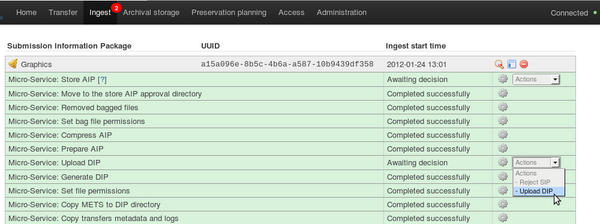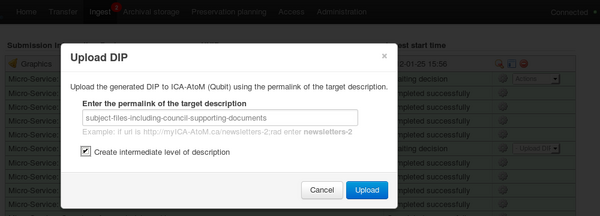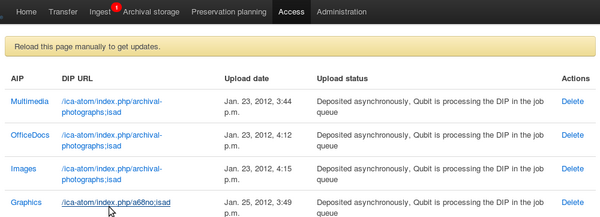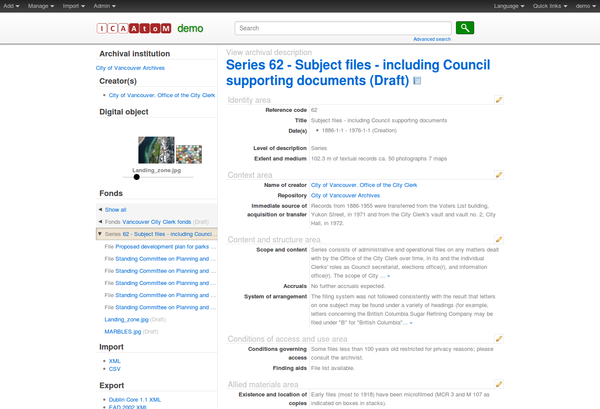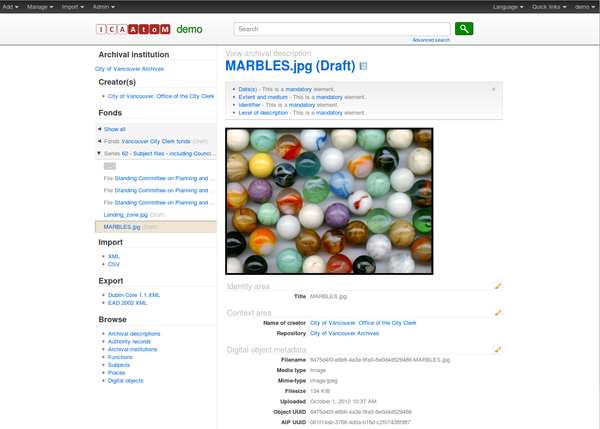CONTENTdm
Main Page > Documentation > User manual > User manual 0.10-beta > CONTENTdm
General description
Users can process digital content and then upload the DIP to CONTENTdm as the access system. To configure Archivematica to upload a DIP to CONTENTdm, see Administrator manual - CONTENTdm upload Please note the user must create the description in CONTENTdm before uploading the DIP.
Should you run into an error during this process, please see Error handling.
More information on Archivematica's CONTENTdm integration is available on the Archivematica wiki: see [[ ]].
Transfer
A transfer package has two directories “objects” and “metadata”. In the case of simple objects (e.g., single-page items), the “objects” directory contains files, and each of the files corresponds to a simple object. In the case of compound objects (e.g., books consisting of multiple pages), the “objects” directory has a directory for each compound object where all files for the compound item (e.g., pages of a book) are placed. In both cases, the “metadata” directory contains a CSV file that meets the metadata import specifications: [Metadata import] figure 1 shows the directory structure of a transfer package of compound objects "CDMtest02"
Upload DIP
Important note: The user must create the target description in AtoM (or other access system) before uploading the DIP. The user will need to indicate part of the description's URL or a target collection in order to send the DIP to the appropriate place during DIP upload.
In this example, we will upload a DIP to the sample description shown in figure 1, above.
- In the ingest tab, select "Upload DIP" in the upload DIP Actions drop-down menu (figure 2).
- A dialogue box will appear (figure 3).
- To upload the DIP to the level of description pictured in figure 1, enter the permalink of the description in the dialogue box: subject-files-including-council-supporting-documents
- Click on "Create intermediate level of description" to create an archival description from the Dublin Core metadata you entered during ingest.
- If you chose not to click this box, the digital objects would be uploaded as immediate child levels of the level of description to which the DIP is being uploaded. This might be useful for, for example, a collection of digitized images which was not hierarchically arranged into lower levels of description.
- Click the blue "Upload" button.
- When the DIP has finished uploading, open the Access tab in the dashboard. This tab shows the AIP and its uploaded DIP. Click on the DIP URL to go to the uploaded DIP in AtoM (figure 4).
- If you are not already logged in to AtoM you will need to log in using the email demo@example.com and the password demo.
- You will see an archival description with the metadata you added during ingest, displayed in the context of the level of archival description to which the DIP was uploaded (figure 5). To view an individual digital object, scroll through the thumbnails on the left of the screen and click on an image.
- Figure 6 shows the digital object displayed in Qubit. Clicking on the image will open the uploaded object.
Upload DIP to CONTENTdm
To configure Archivematica to upload a DIP to CONTENTdm, see Administrator manual - CONTENTdm upload
